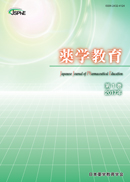Volume 1
Displaying 1-15 of 15 articles from this issue
- |<
- <
- 1
- >
- >|
Review Article
-
Article type: Review Article
2017 Volume 1 Article ID: 2017-003
Published: 2017
Released on J-STAGE: June 30, 2017
Download PDF (348K) Full view HTML
Special Topics “At the beginning of pharmaceutical education research”
-
Article type: Review Article
2017 Volume 1 Article ID: 2017-011
Published: 2017
Released on J-STAGE: June 30, 2017
Download PDF (389K) Full view HTML -
Article type: Review Article
2017 Volume 1 Article ID: 2017-001
Published: 2017
Released on J-STAGE: June 30, 2017
Download PDF (356K) Full view HTML -
Article type: Review Article
2017 Volume 1 Article ID: 2017-002
Published: 2017
Released on J-STAGE: June 30, 2017
Download PDF (521K) Full view HTML -
Article type: Review Article
2017 Volume 1 Article ID: 2017-006
Published: 2017
Released on J-STAGE: June 30, 2017
Download PDF (449K) Full view HTML
Original Article
-
Article type: Original Article
2017 Volume 1 Article ID: 2017-007
Published: 2017
Released on J-STAGE: December 01, 2017
Download PDF (2684K) Full view HTML
Practical Article
-
Article type: Practical Article
2017 Volume 1 Article ID: 2016-002
Published: 2017
Released on J-STAGE: June 30, 2017
Download PDF (998K) Full view HTML -
Article type: Practical Article
2017 Volume 1 Article ID: 2016-003
Published: 2017
Released on J-STAGE: August 18, 2017
Download PDF (3584K) Full view HTML -
Article type: Practical Article
2017 Volume 1 Article ID: 2016-001
Published: 2017
Released on J-STAGE: August 30, 2017
Download PDF (2053K) Full view HTML -
Article type: Practical Article
2017 Volume 1 Article ID: 2017-005
Published: 2017
Released on J-STAGE: October 04, 2017
Download PDF (2922K) Full view HTML -
Article type: Practical Article
2017 Volume 1 Article ID: 2017-008
Published: 2017
Released on J-STAGE: October 12, 2017
Download PDF (497K) Full view HTML -
Article type: Practical Article
2017 Volume 1 Article ID: 2017-009
Published: 2017
Released on J-STAGE: November 14, 2017
Download PDF (2963K) Full view HTML -
Article type: Practical Article
2017 Volume 1 Article ID: 2017-010
Published: 2017
Released on J-STAGE: November 14, 2017
Download PDF (1236K) Full view HTML -
Article type: Practical Article
2017 Volume 1 Article ID: 2017-015
Published: 2017
Released on J-STAGE: December 01, 2017
Download PDF (3523K) Full view HTML -
Article type: Practical Article
2017 Volume 1 Article ID: 2017-012
Published: 2017
Released on J-STAGE: December 09, 2017
Download PDF (2385K) Full view HTML
- |<
- <
- 1
- >
- >|
